Known as the “Paris of the East” and considered the “pearl of the Danube”, Budapest is the elegant capital of Hungary. The millions of tourists who visit it every year are fascinated by this majestic city divided into two banks, Buda and Pest, both overlooking the Danube and joined by splendid bridges, such as the Chain Bridge 🌉. On the western bank of the river, we find the ancient Obuda, the first Roman settlement, and Buda with its hill, on which stands the medieval quarter with the Royal Palace and the beautiful Gothic-style Matthias Church. On the eastern side is Pest, a modern and lively city, full of shops, hotels, restaurants and night clubs. A walk along Andrassy Avenue is not to be missed, as far as the National Opera House and the magnificent Heroes’ Square. Also worth seeing are the majestic Parliament, St. Stephen’s Basilica, and Margaret Island. Finally, relax at Cafè New York ☕ and of course in one of the many ancient thermal baths 🛀 of this city rich in natural springs, many of which are outdoors.

This time we did not visit the city as a couple but with our school.
In fact, Budapest is a very popular destination for secondary school pupils 👪.
Among other things, for both of us, it was our first city outside Italy that we visited.
What impressed us the most was the cleanliness of the streets and their organization, as well as the splendid monuments and churches that we are going to talk about now.
THE BUDA DISTRICT
The Buda district, located in the upper part of the city, was the first nucleus of the city of Budapest. On this hill and within the walls of the Castle the inhabitants of Pest came to take refuge when the attacks of the Mongols became unsustainable. Today it houses the Royal Palace, the Matthias Church, and some very beautiful views. Definitely one of the places in Budapest to absolutely see.
Buda is a small city within the city, where you have the feeling of returning to the past, capable of offering enchanting corners and splendid views.
Buda can be reached by funicular (recommended) that leaves from the Chain Bridge or by buses 16A and 116 from Moszkva square. Those who feel like it and have a sporty soul, from Piazza Clark, will be able to face the steps of the Royal Staircase.
Royal Palace
The area south of Buda is occupied by the Royal Palace which dominates the city from the top of the hill. Born as a fortress in the Middle Ages, it was transformed into a splendid Renaissance palace under the reign of Mattia Corvino. Burned and bombed during the war, it underwent a long restoration that gave the castle a more sober appearance than in the past. The Palace was the residence of the Hungarian sovereigns for over 700 years, but today it is home to museums and cultural institutions and it is a UNESCO World Heritage Site 🌍.

Its 304 meter long façade is made up of two wings divided by a central dome. During your visit, you will come across the giant bronze bird of prey Turul 🐦, a symbol of the tribes who seem to want to take flight from the pillar of the entrance gate; the beautiful equestrian statue of Eugenio di Savoia 🐎 which offers an incomparable panorama; in the monumental fountain of King Mattia ⛲ depicting the king in a hunting outfit and the beautiful Elena, the protagonist of a well-known romantic ballad (that we do not know).
As mentioned, the Royal Palace houses several museums: the Hungarian National Gallery with its exceptional collection of Hungarian art that shows its evolution from the Middle Ages to today. Do not miss the part of the collection dedicated to the late Gothic altarpieces. Instead, in the Historical Museum of Budapest, there are exhibited all the archaeological finds that are part of the history of the city from the first settlements of the Roman era up to the 13th century, finally, the Széchenyi National Library 📚, the most important library of Hungary retains the famous Corvinian codes.
Opening hours: the castle courtyard is always open. National Gallery from Tuesday to Sunday, 10 am-6 pm. The ticket office closes at 5 pm. Closed on Mondays.
Full ticket: 3200 HUF, around 8 €
The Matthias Church
The oldest building in the district is the Church of Maria Maddalena ⛪ but the real jewel is represented by the Church of Mattia Corvino erected more than 700 years ago in Piazza della SS. Trinity, the main one in the district.
In the square, it is also possible to admire the votive column of the Trinity, built by the survivors of the plague as a sign of thanks, and the baroque building of the Old Town Hall.
During the Turkish occupation, the church was transformed into a mosque 🕌. In 1896, the renovation works directed by the architect Frigyes Schulek began and took on its current Gothic appearance.
In addition to being one of the most important religious places in Budapest, the Church was also the scene of memorable coronations 👑 including that of Franz Joseph I and his wife Elizabeth (Sissi).

The acoustics of the Church is perfect, so much so that organ concerts are held there all year round.
The Church is characterized, on the outside, by the presence of two towers, the highest (80 meters) is the Mattia tower with a lacy stone spire, the lowest in Romanesque style is the Bèla tower. The interior of the Church, with its stained glass windows, frescoes, and wall decorations by Hungarian artists Lotz, Szèleky, and Zichy, is striking for how Art Nouveau style, oriental influences, and Hungarian folk tradition blend together. The Church preserves a rich collection of religious art, relics, memorabilia of coronations, and some Hungarian treasures.
Opening hours: church hours depend on religious services. The visits alternate with interruptions for the masses.
Full ticket: 1600 HUF, around € 7
The Fishermen’s Bastion
Behind the church is the Fishermen’s Bastion, a beautiful panoramic terrace from which you can enjoy a splendid view of the Danube and Pest. The fairytale fortress is embellished with cloisters, stairways, and seven turrets representing the seven Magyar tribes who conquered the lands where Hungary is today. It is not yet clear whether the Bastion owes its name to the fish market that took place here in medieval times or to the guild of fishermen who in the Middle Ages had the task of defending this stretch of walls. In front of the Bastion stands the equestrian statue of King Stephen, founder of the Hungarian nation.
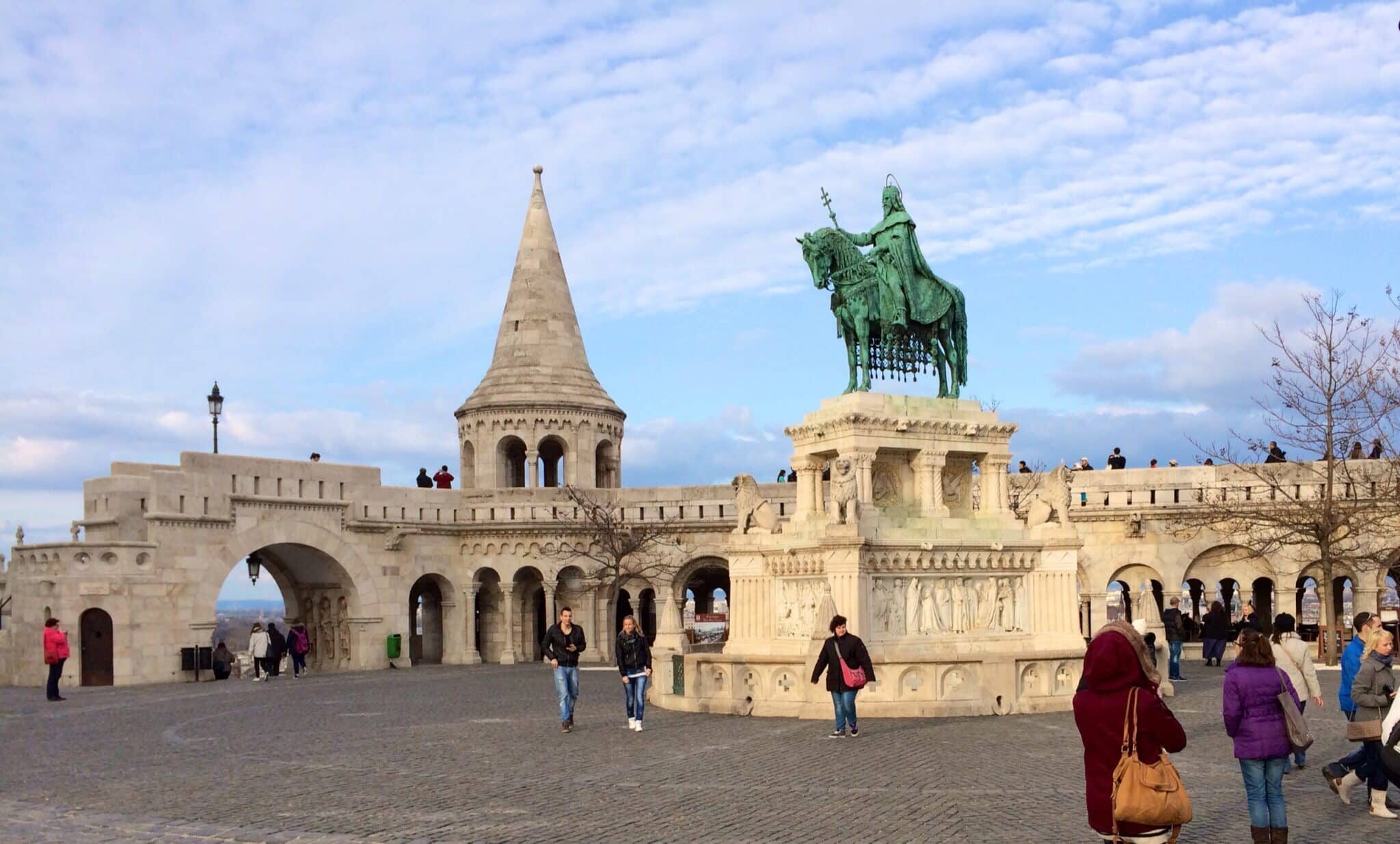
But why Fisherman’s Bastion is called “Fisherman’s” 🐟?
There are several theories about the meaning behind the name Fisherman’s Bastion, although none can be 100 proved as accurate. One theory is that it got its name from the fisherman in Watertown. The city was located just below the Bastion. The reasons for naming the Bastion after them range from as simple as their close proximity, to legends of how they defended the Bastion’s walls in times of war and conflict. A second theory tends to lean more towards the fish market located at St. Matthias church giving way to the Bastons name. Although no one can be undoubtedly sure the Fisherman’s name stuck and lives on to this day.

Heroes’ Square
The solemn Heroes’ Square is the largest square in Budapest. A square with the Millennium Monument in the center, built to celebrate the thousandth anniversary of the Magyar conquest.

A semicircular colonnade divided in two where the statues of the most important men of Hungarian history are placed that symbolize work, prosperity, wisdom, glory and peace. In the middle of the colonnade stands a 36-meter high pillar on top of which the Archangel Gabriel holds the Holy Crown and the apostolic cross in his hand.
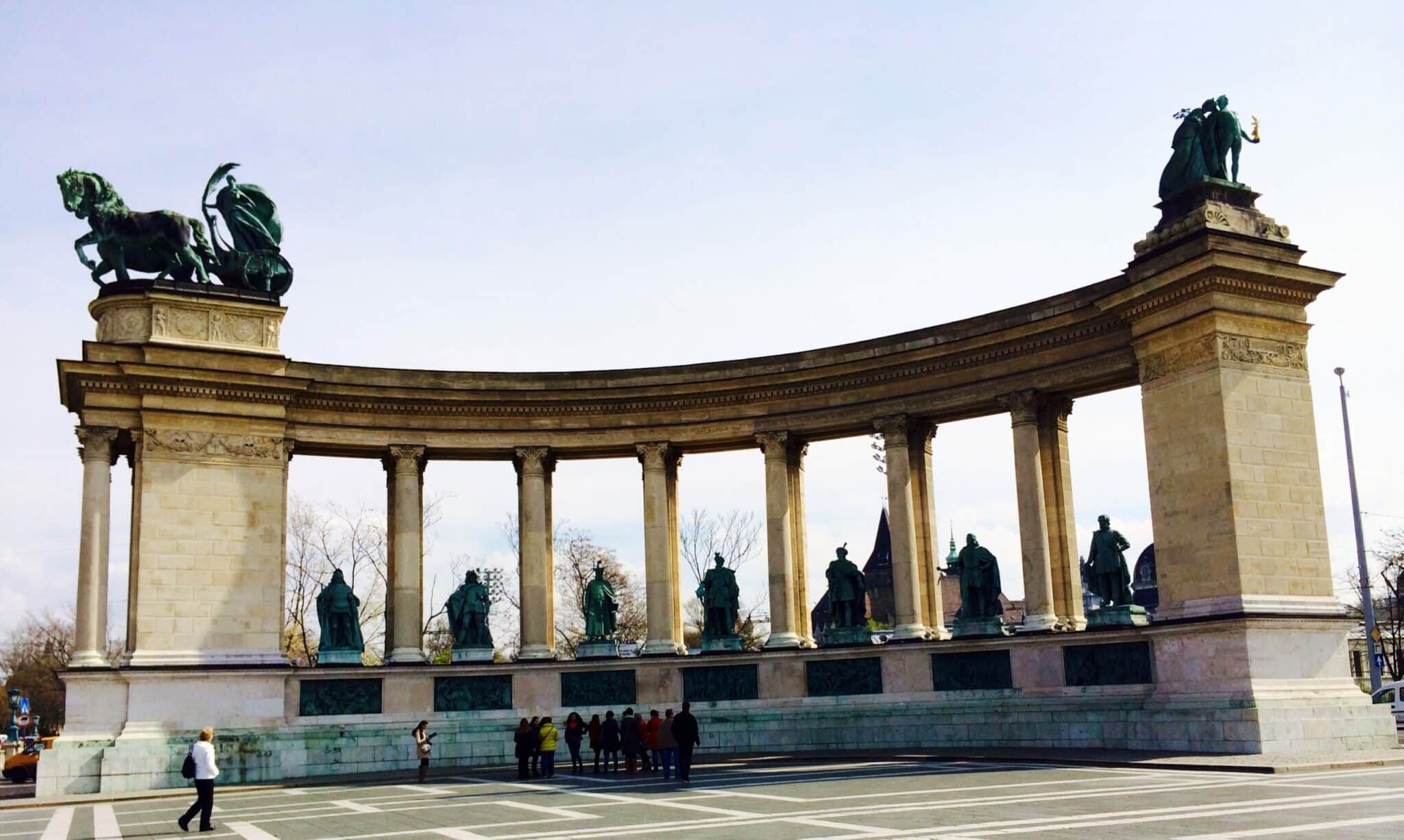
Curiosity
Equally spectacular is the subsoil of Buda. In fact, a system of caves and caverns rich in thermal springs that form a labyrinth over ten kilometers long extends under the Hill.
THE PEST DISTRICT
If Buda is the ancient and noble part of Budapest, Pest instead is its modern and innovative heart, all gathered around the Castle 🏰.
Pest does not have great museums to see: here the creative Budapest stands out, with the little shops of designers and young artists. However, there is no shortage of things to see: the Parliament Building and the Cathedral of Santo Stefano, the Great Synagogue 🕍 , and the Ethnographic Museum. It is also the ideal part of Budapest for shopping 👛: there is a lot to spend on Andrássy Avenue. There is also a House of Terror 👽, used by both the Nazis and the Communists, as a place of torture.
Pest has the flavor of the ever-moving metropolis, with its eclectic buildings, offices, expensive restaurants 🍝 , and trendy boutiques 👕. But it is also a popular district with numerous outdoor cafes, stalls, suggestive squares that are always lively where liveliness and tradition are mixed.
Parliament of Budapest
The Parliament of Budapest is one of the city’s symbols, perhaps the best known and most photographed. It was built between 1885 and 1904 by the architect Imre Steindl, who was inspired by the London Parliament and Cologne Cathedral.
The Gothic exterior, which imposes itself with spires, turrets, arches, and windows, is contrasted by the Baroque and Renaissance styles of the interior.
Covering nearly 18,000 square meters, it contains 27 entrances and 691 rooms (they are crazy). No doubt about it, the President of the Republic, the Prime Minister, and the parliamentarians have a pretty good home in which to carry out their functions!

It is located in Kossuth Square, in the historic center.

Opening: from May to September: 8 am-6 pm Monday, Wednesday, Thursday, and Friday. 8-16 Saturday and 8-14 Sunday. From October to April: 8-16 Monday, Wednesday, Thursday, Friday, and Saturday. 8-14 Sunday.
Cost For tourists from EU countries, the visit is free upon presentation of a document.
Basilica of Santo Stefano
The Basilica of Santo Stefano is a Catholic basilica located in the center of Budapest. At first, the building was to be named St. Leopold, patron saint of Austria, but at the last minute, the church was baptized with the name of Stephen, the first king of Hungary 👑, whose right hand is found in the reliquary of the basilica. Today, the Basilica of Santo Stefano is the third-largest church ⛪in the country.
The site where the Basilica stands today was a theater 🎭 in the 18th century, a place where animal fights were hosted until one of the wealthiest citizens financed the construction of a provisional church right inside the structure. In the early 1800s, a few hundred people began raising funds to design the future construction of a permanent church, what is now St. Stephen’s Basilica. The church was completed in 1905 after 54 years of construction. The work was started by the architect Miklós Ybl and was later completed by József Kauser.
On a par with the Hungarian Parliament Building, at 96 meters the Basilica is one of the two tallest buildings in Budapest. This parity symbolized at the time the equality between the importance of secular power and spiritual power in the city.

The facade is characterized by two large bell towers 🔔; in the south tower, there is the largest bell in Hungary. The two towers have six bells in total: five are located in the north side tower, while the largest bell, mentioned above, is the only one in the south tower. This elli s usually used twice a year: on August 20, which is the date on which the church was consecrated, and on December 31.
Open from Monday to Friday from 9.00 to 17.00, on Saturday from 9.00 to 13.00 and on Sunday from 13.00 to 17.00. Entrance to the building is free, with the exception of a visit to the Dome, which is only open from spring to autumn.
Great Synagogue
Budapest has always had a large Jewish community. 22 synagogues are still active today, many of which are in schools, hospitals or private homes. Right in the heart of the Jewish ghetto is the largest synagogue in Europe.
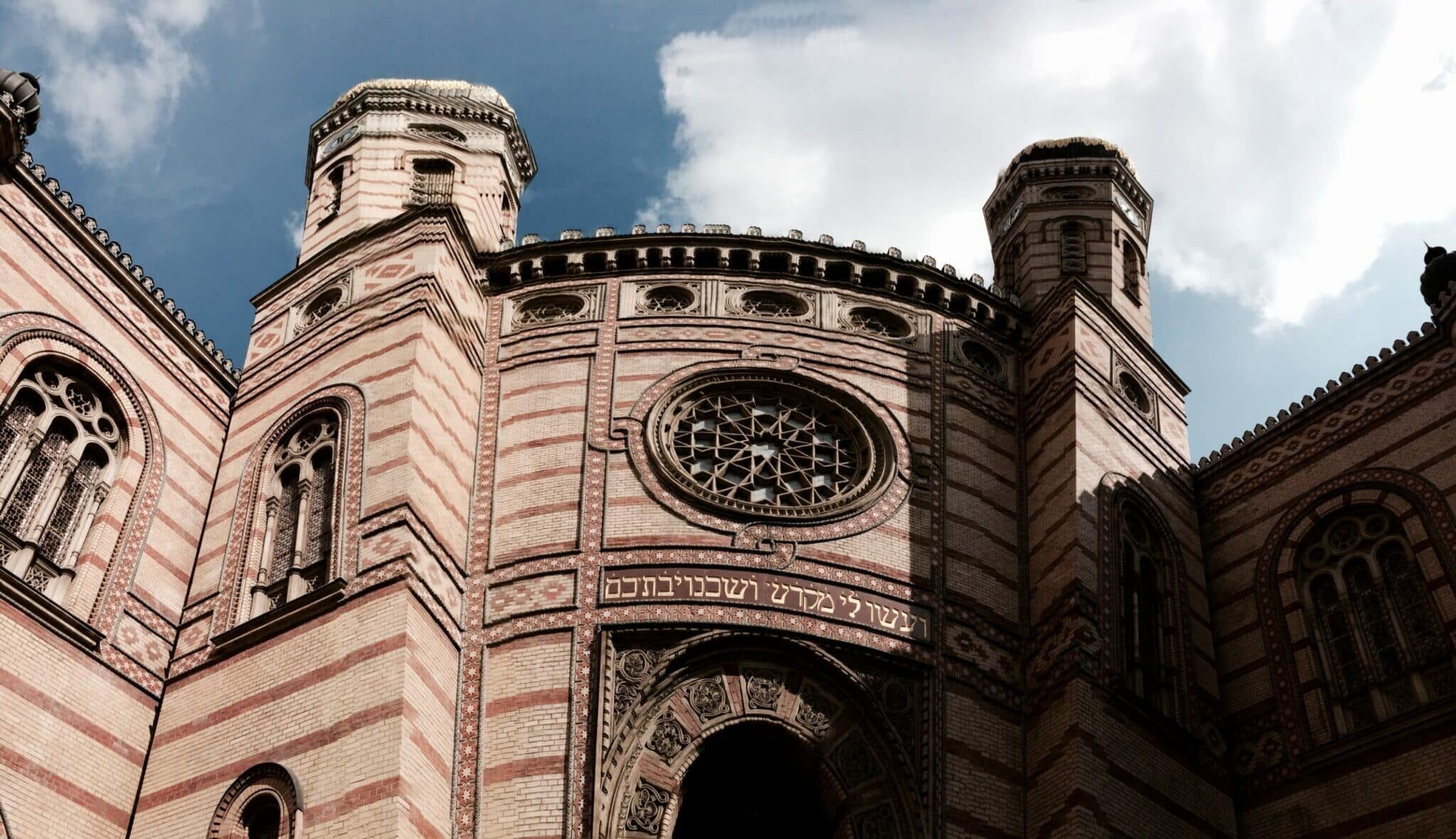
Built in 1859 in a Neo-Moorish style, it can accommodate up to 3000 people. In the lower part of the synagogue, there are places for 1497 men, while on the upper floor there are places for 1472 women. In the garden of the Synagogue, there is a monument that remembers the Jews killed by the Nazis in 1944-45: it is a willow tree, called the “Tree of Life“🌳, with metal leaves. The name of a martyr is engraved on each of them.

This beautiful synagogue is located in Dohány Utca, in the historic center.
Times vary depending on the period of the year and religious services.
Closed: 1 and 18 January, 15 March, 9, 10, 15, 16 April. 29 and 30 May. 18, 19, 20, 27, 28 September 3, 4, 10, 11, 23 October. November 1. 24 and 25 December.
Cost: 1600 HUF (about 7 €).
Ethnographic Museum
The Ethnographic Museum of Budapest is particularly interesting for its permanent exhibition, dedicated to the customs and traditions of the Hungarian people, in addition to the other temporary exhibitions it hosts.
The collection displays period photographs, clothes, furniture, and tools, demonstrating what life was like for the inhabitants, both in the countryside and in the city, from the 18th century to the First World War.
In addition to the exhibitions dedicated to Hungarian traditions, there are also exhibitions in Europe, Asia, Africa, America, and Oceania.
Cost:
Adults: 1,400Ft (€ 3.90)
European citizens, between 6 and 26 and between 62 and 70 years: 700Ft (2 €)
Children under 6 and over 70: free admission.
Gresham Palace
The Gresham Palace is one of the finest examples of Art Nouveau in the city. The splendid building overlooking the Danube was once the headquarters of the London-based insurance company Gresham, today it is a luxury hotel of the Four Seasons chain 🏩.
With its facade adorned with worked glass windows, mosaics, inlays, nature-inspired ceramic decorations, and sculptures, it represents one of the architectural symbols of Budapest.
Vörösmarty square
The beating heart of Pest is Vörösmarty square, the elegant square with luxury shops, typical cafes, and art galleries and overlooked by the old Gerbeaud pastry shop 🍰, famous for its marasca cherries with cognac and, above all for Dobos, the cake exported all over the world. Around the square opens the main Budapest shopping street.
For cheaper and certainly more original purchases, it is really worth visiting the nearby Vásárcsarnok, the central covered market, the most beautiful in the capital and the largest in Europe. A huge red brick building with a majolica roof, dominated by neo-Gothic towers inside which colorful food stalls, small craft shops, and unique bistros alternate. Here you can really find everything and at a good price, leaving it empty-handed is practically impossible!
THE OBUDA DISTRICT
Obuda is the oldest district of Budapest. Its origin dates back to 35 BC (VERY OLD 😱) when the Romans founded the military city of Aquincum, the capital of the province of Pannonia.
In the Middle Ages, Obuda was called Buda, it was the king’s residence 👑 and, consequently, the most important center. However, when King Bèla IV moved to the hill of the fortress the city began to lose importance until it even lost its name which, since then, was Obuda.
The heart of Obuda is the beautiful central square where the 18th-century Zichy palace excels. Today the neo-baroque castle houses the Kassák Museum with exhibits of the works of the poet and painter Lajos Kassák, the main exponent of the Hungarian avant-garde, and the Vasarely Museum dedicated to the father of kinetic art, known as Optical Art.
The archaeological excavations
In the area of the archaeological excavations, there are the remains of public buildings, houses and shops, the macellum (covered market), the basilica and the forum, the large public baths, and finally the temple dedicated to the cult of the Sun God.
Aquincum Museum
The objects and findings are exhibited in the Aquincum Museum, where you can admire murals, the water organ, and many other artifacts from the past. The lapidary is particularly rich in elements, as shown by the funerary steles, the stone sarcophagi, the commemorative tables outside the museum.
ADVICE: MORE TO SEE and TO DO
Danube cruise
If you’re visiting the city for the first time, there’s probably no better way to explore it than a scenic Danube cruise 🚢! Sit back and relax as you glimpse amazing sights, representing the city’s rich history and culture.
The famous Budapest skyline stretches from the Chain Bridge to the Technical University on the Buda side and includes Gellért Hill with the Statue of Liberty and the Buda Castle complex.
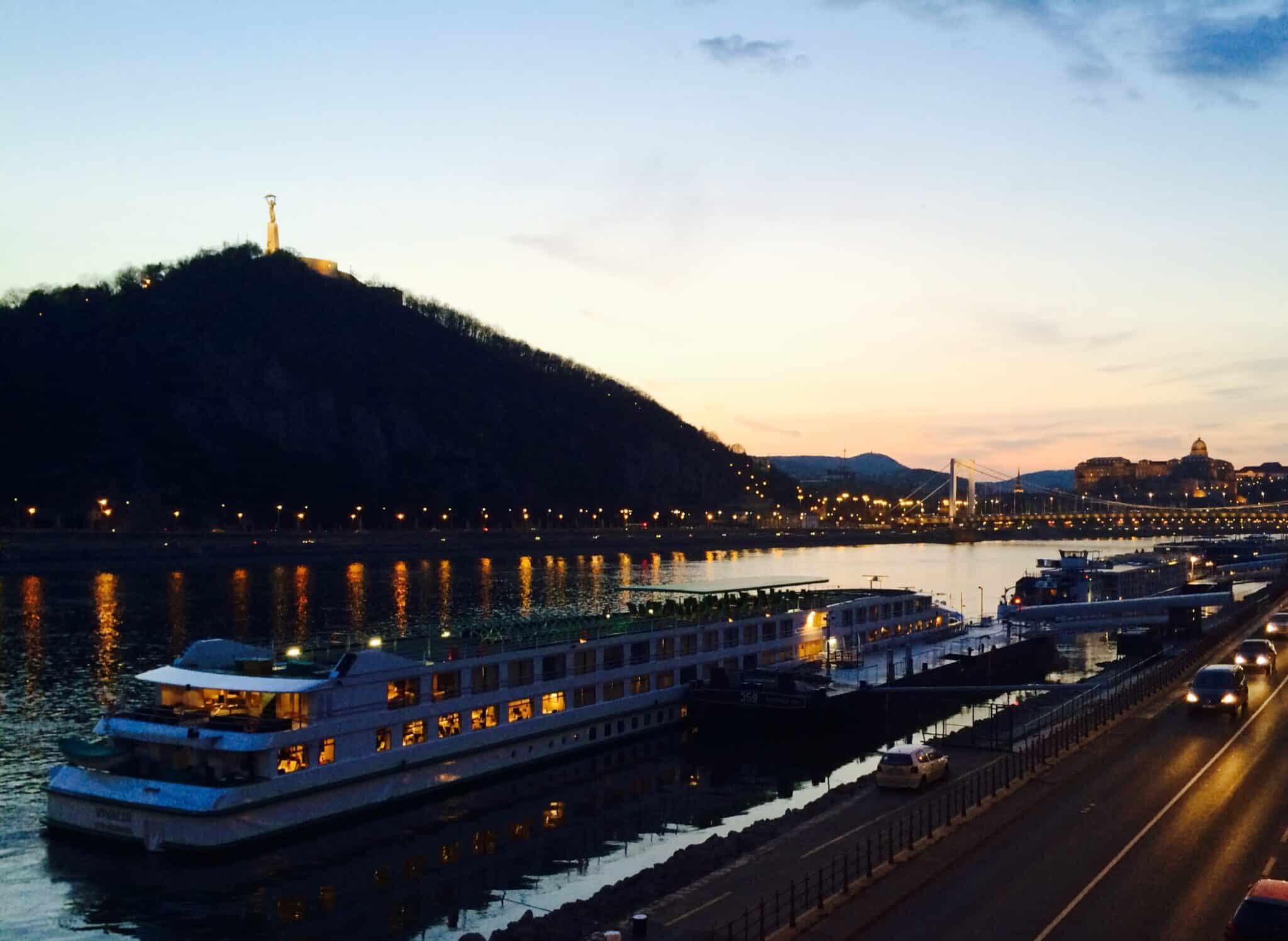
Combo tours are popular, generally including a cruise on the Danube with a delicious lunch or dinner served on board and sometimes accompanied by fiery folk music.
River cruises on the Danube will undoubtedly leave you with a memory for a lifetime – explore both sides of fascinating Budapest and discover its most important attractions.
The Chain Bridge
For centuries Buda and Pest have been two separate cities. Only in the spring and summer months, when the climate allowed it, were they connected by floating bridges which were then dismantled during the winter. According to legend, the construction of a fixed bridge is due to Count István Széchenyi, from whom the bridge takes its official name. The Count had his father dying in Buda while he was in Pest: not only was he unable to give him the last farewell but he had to wait a week before being able to attend the funeral. So he decided to have the bridge designed by the English engineer William Tierney Clark and to have the Scottish Adam Clark follow the work. The works, which began in 1839, ended exactly 10 years later.
The bridge is named after the “chains” that decorate the sides and, in reality, it is only the large copy of a bridge (Marlow Bridge) that William Clark had built on the bank of the Thames in Marlow, England. At the end of the bridge, there are lions and other symbols: according to a legend, these sculpted lions have no tongues and this would have prompted Adam Clark to commit suicide out of shame. The engineer was very proud of his bridge and challenged anyone to build a bigger and more beautiful one. In reality, lions have tongues, but you can only understand it by seeing them from above. The bridge was, at the time, a real wonder: 202 meters long it was the largest single-span bridge in the world and remained undefeated for a long time. It was the retreating German Nazis who knocked it down but it was rebuilt in 1949 on the occasion of the centenary.

The thermal baths
The Romans founded “Aqiuncum” with some grandiose thermal baths 🛀, the remains of which can still be seen today in various places in Óbuda. Since then, Budapest has always been a Spa city and has not lost this characteristic even when it became a metropolis: today it is the only European capital with Spas and in 1934 it received the nickname of “Spa city“.
In particular, the Széchenyi Baths are one of the largest Spa complexes in Europe. The current building was inaugurated in 1913 and is in neo-Gothic style.
It has 15 swimming pools, 3 large free areas and 12 smaller ones inside. In these areas, there are also saunas and various massage rooms. The most impressive pools are those found outside.

Margaret Island
We absolutely recommend going to Budapest in spring 🌺 to enjoy the beautiful Margaret Island 🌼, which is located right in the middle of the Danube and can be easily reached with the bridge of the same name.
The ideal is to rent a bike on the spot and travel the corners of this islet far and wide, after all, it’s only 2.5 km! Before Margaret Island, there were three distinct islets: the Seaside Island, the Painters’ Island, and the Isle of the Hares. United by concrete in the late 1800s, today they form a single island named after the daughter of King Béla IV, Margaret.
Today it is the favorite place for locals looking for a few hours without smog or going to take a bath in the thermal waters of the large Palatinus outdoor pool.
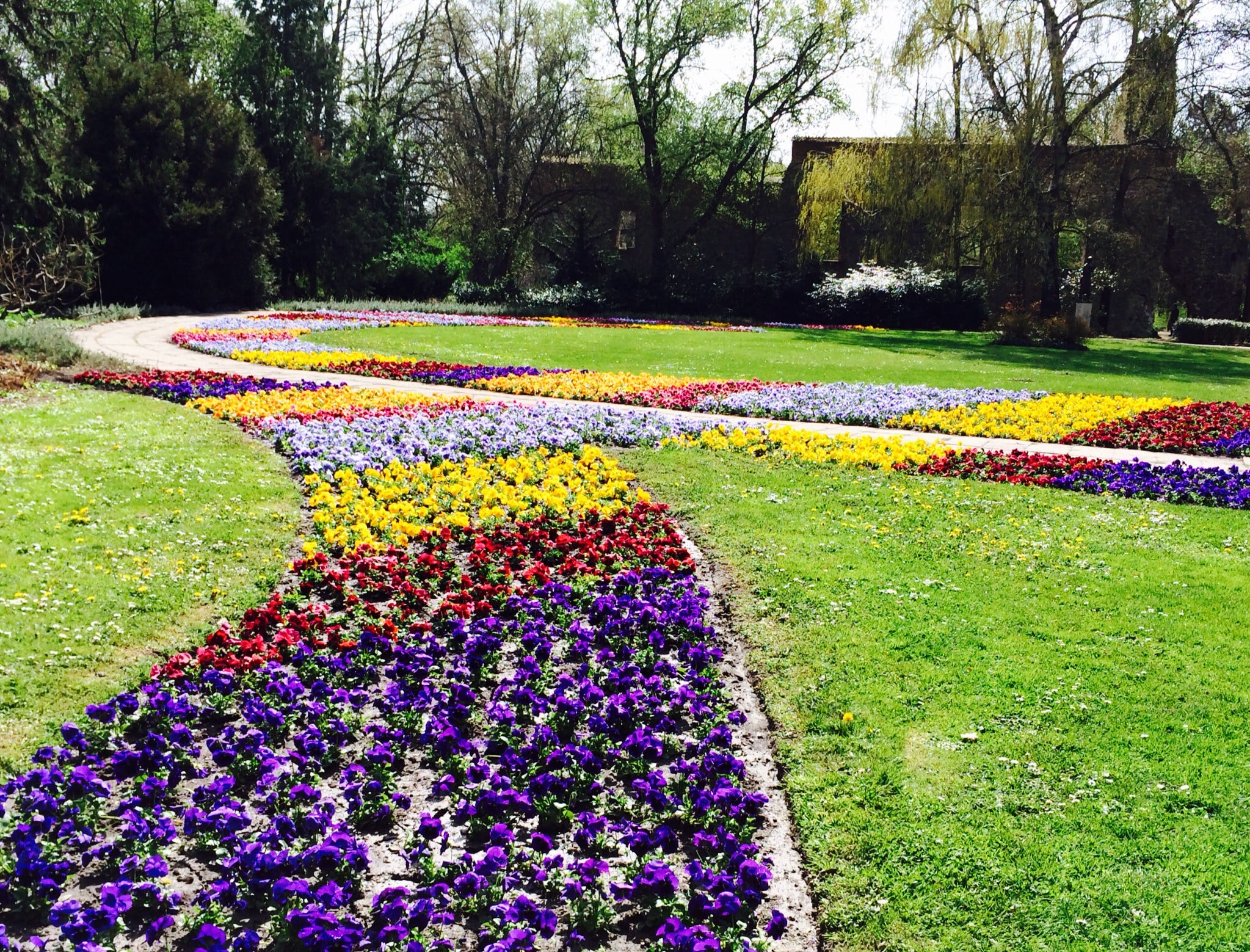
The Shoes on the Danube Banks
On the banks of the Danube, in Budapest, sixty pairs of shoes 👡 are lined up. There are women’s, men’s, and children’s shoes, left there, near the water, abandoned. It is the disturbing and sad memorial in honor of the Hungarian Jews who, in the winter of 1944-45, were killed on the banks of the Danube by the militiamen of the Arrow Cross Party. Known as “The Shoes on the Danube Banks“, the memorial was conceived by director Can Togay, who created it together with the sculptor Gyula Pauer on the Pest bank in 2005. During the days of horror, in the winter of 1944-45, the Danube was known as “the Jewish cemetery“.
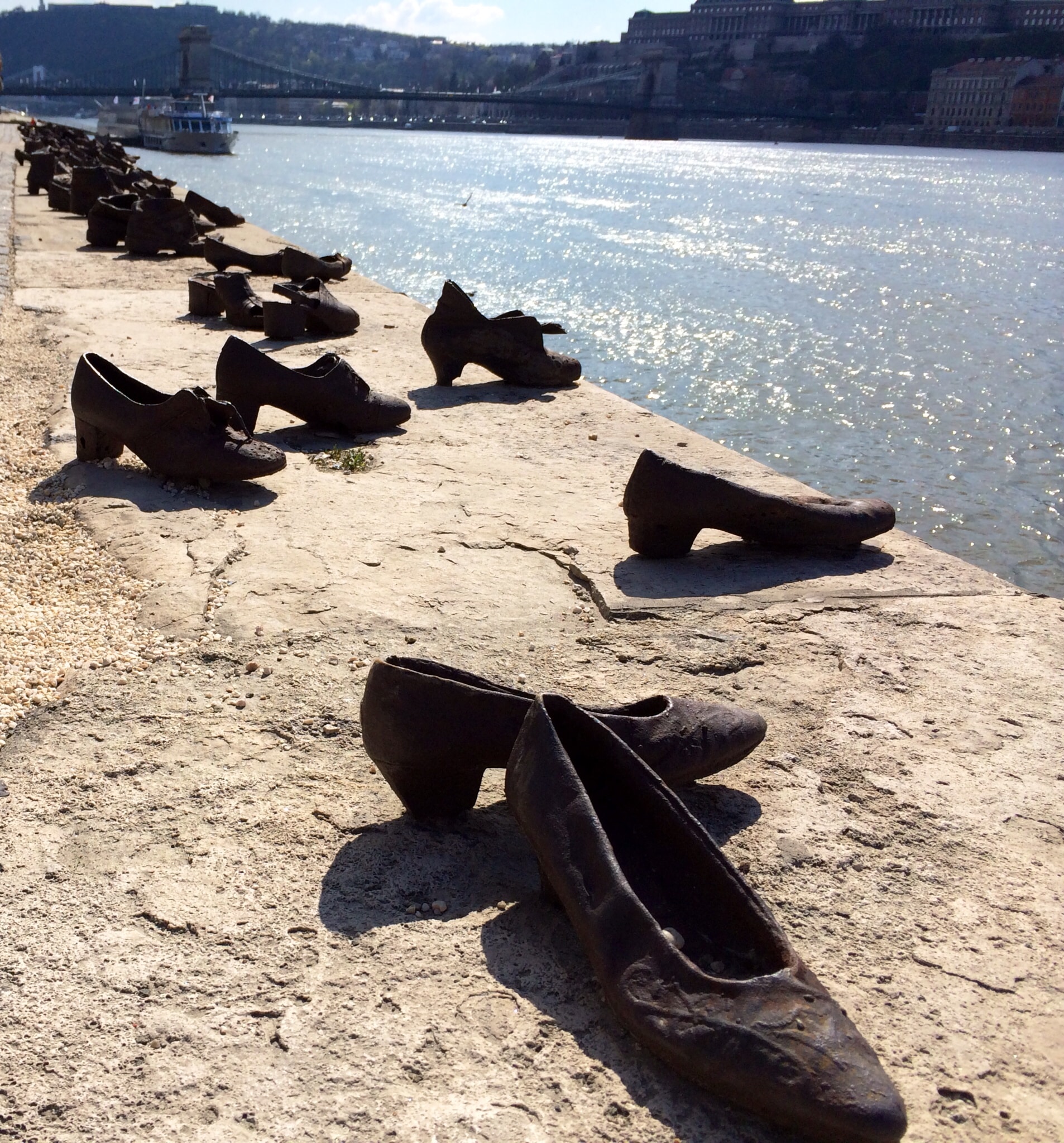
Today there are many candles that are placed daily in their shoes, flowers are placed next to them while a plaque reads “In memory of the victims thrown into the Danube by the militia of the Arrow Crosses in 1944-45. Erected on April 16, 2005“.
What to eat
Meat, potatoes, onions, spices, and paprika are the basis of many dishes from Budapest and Hungary.
Super-calorie preparations that are justified above all by the cold climate ❄, which in winter can even lead to -50 degrees below zero 💢.
The basis of everything, even the famous Goulash, the typical dish par excellence. There is no goulash equal to another because everyone cooks it with a variant: however, meat, potatoes, pepper, and paprika cannot be missing. In addition to Goulash, there are other soups, while the most famous meat dish is pork with (for a change) paprika and potatoes.
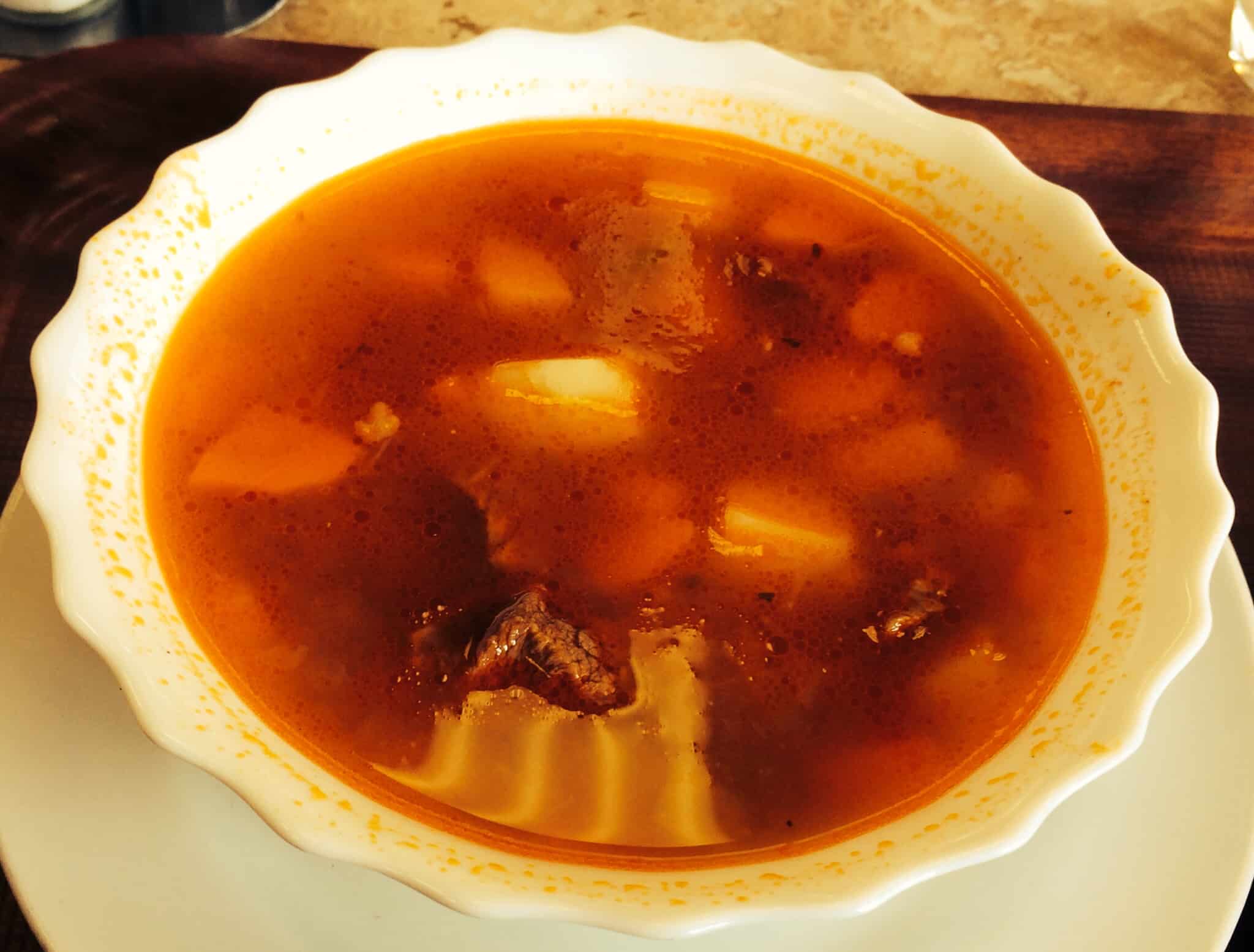
While for sweet lovers, Kurtoskalacs are very fragrant sweets made with brioches dough rolled along with a roller, brushed with butter, baked and flavored at the end of cooking traditionally with cinnamon sugar or poppy seeds, chocolate or vanilla.
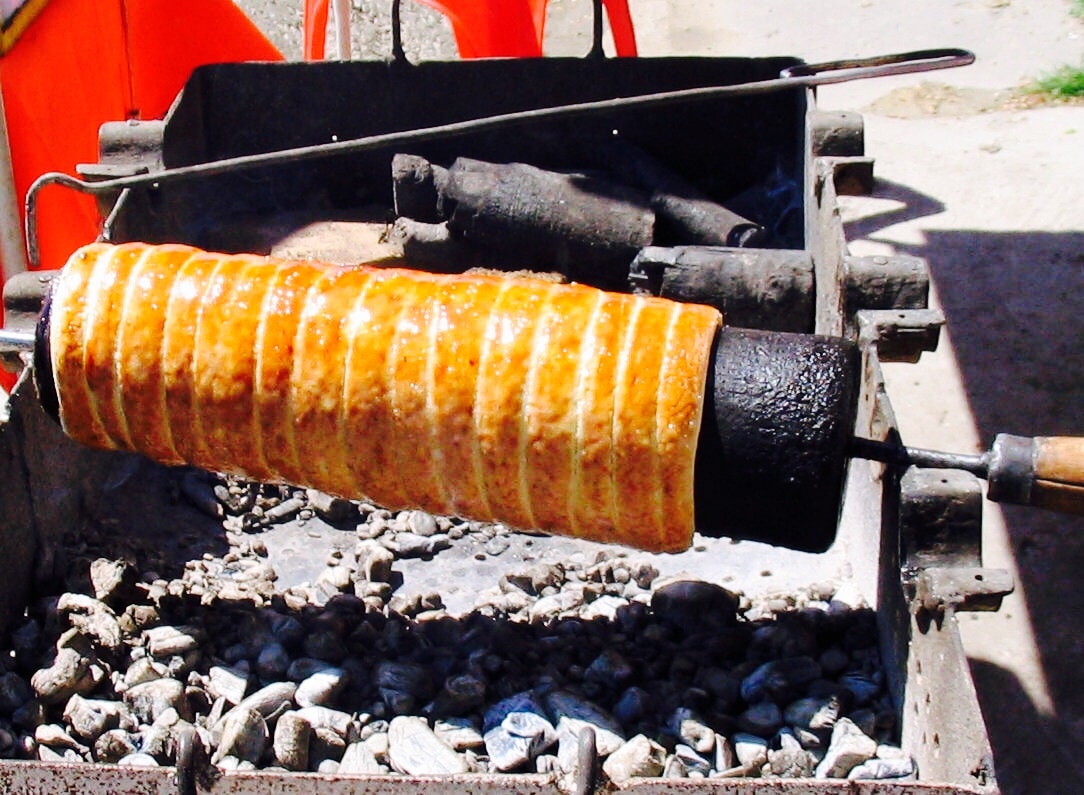

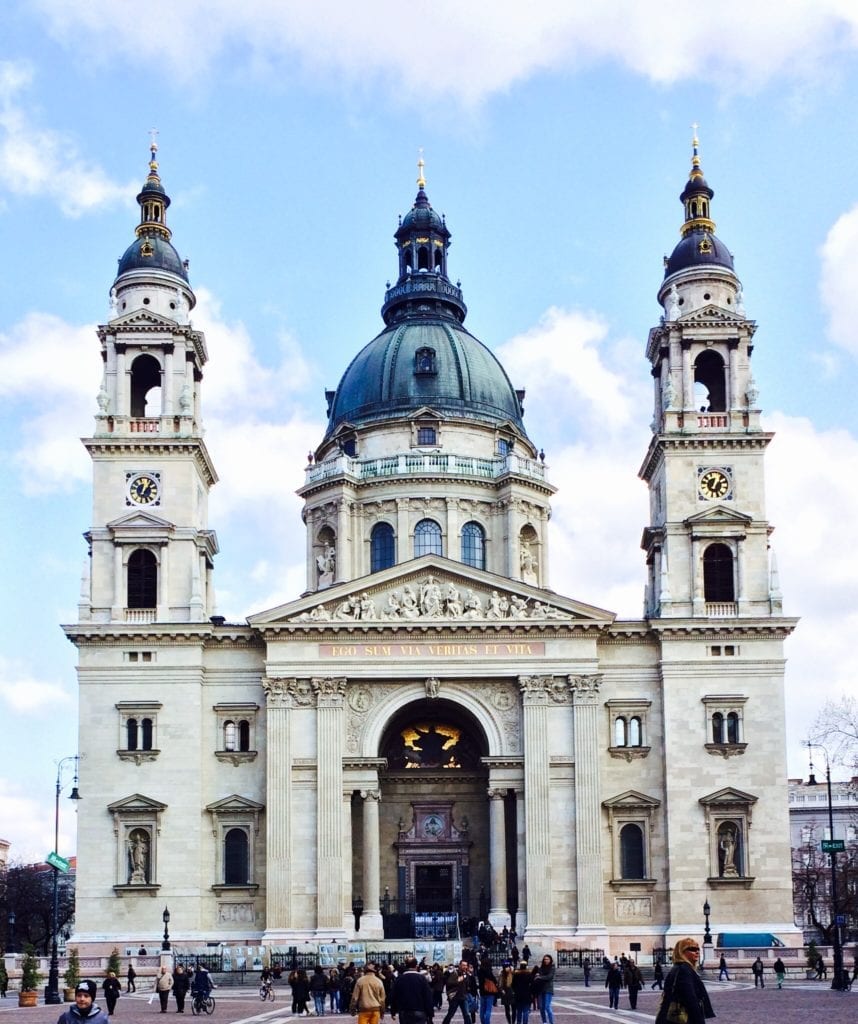


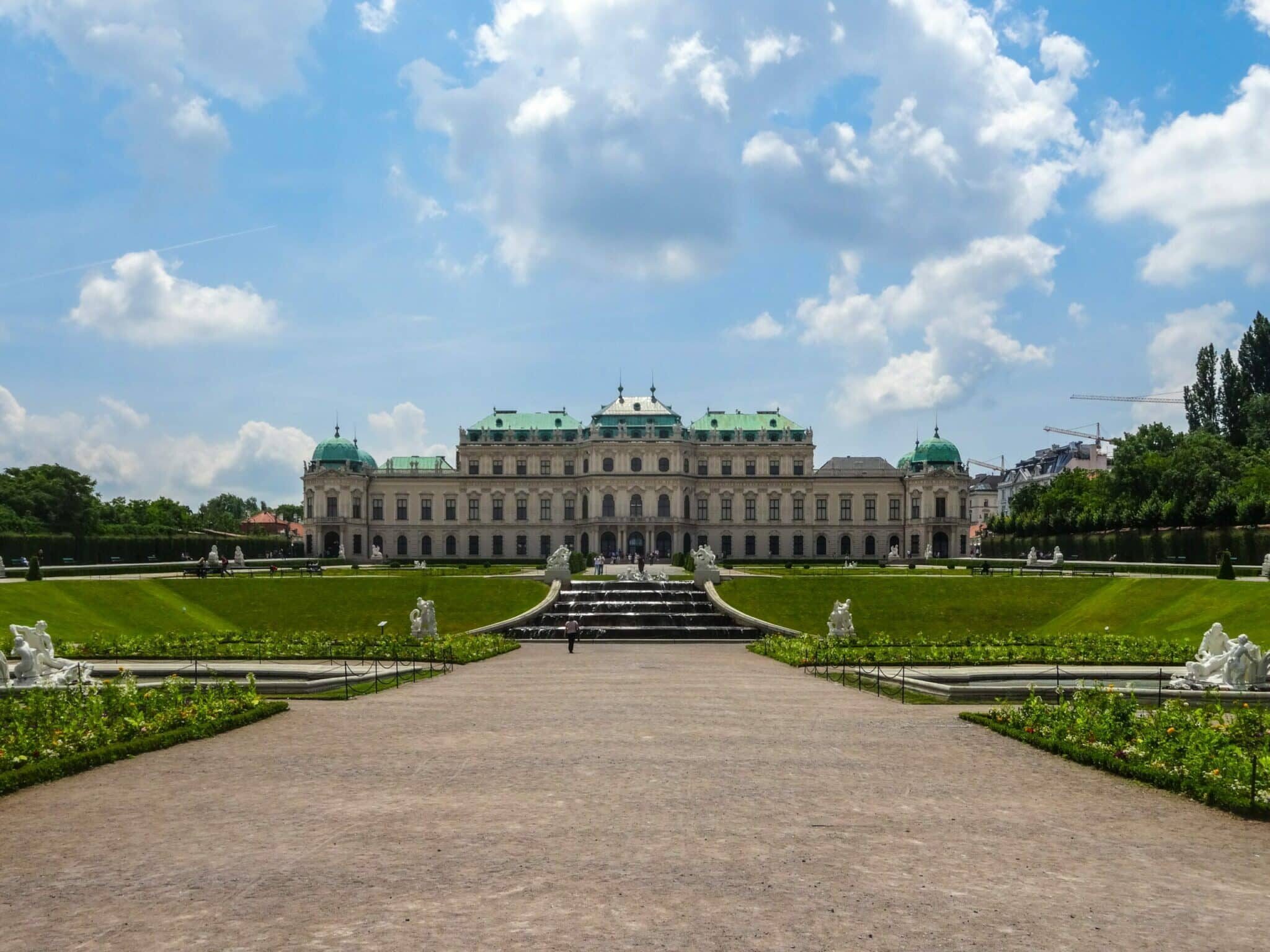
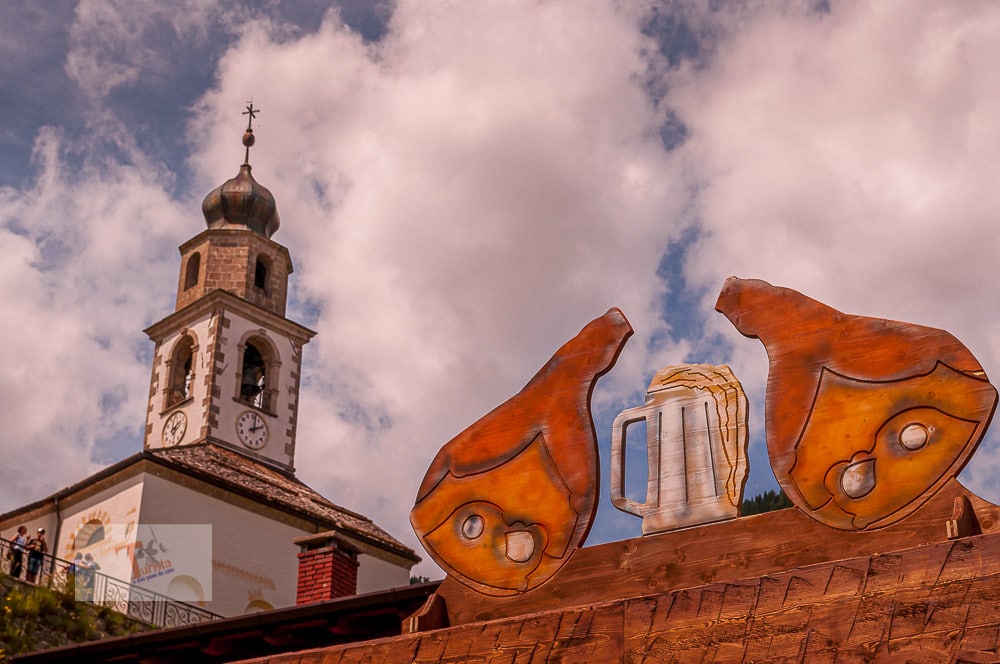
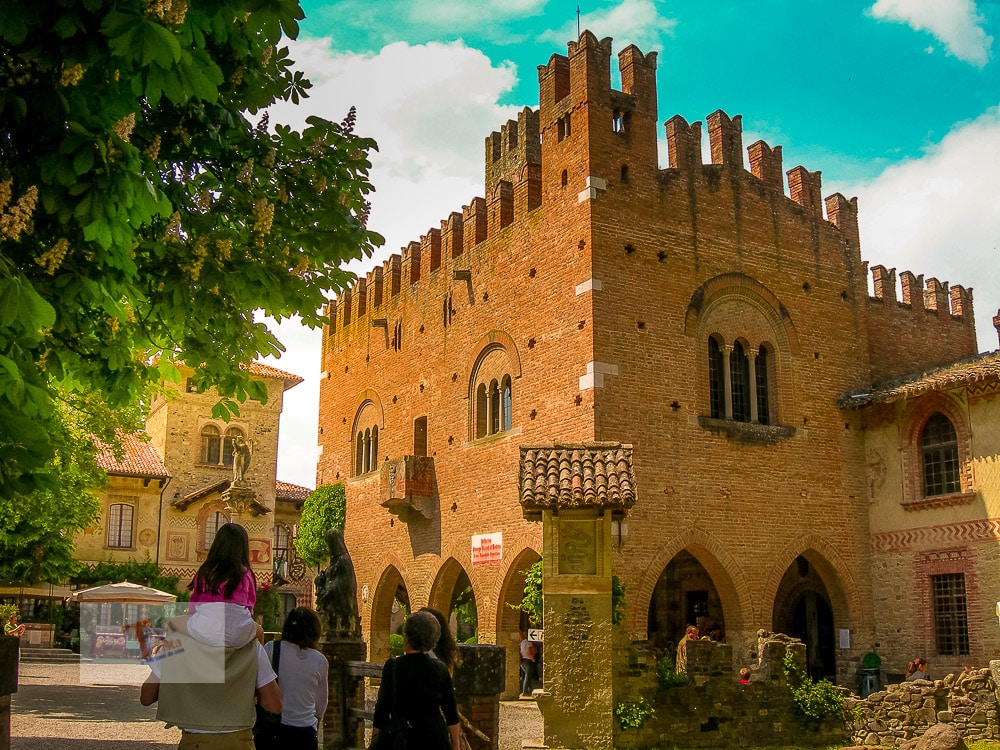
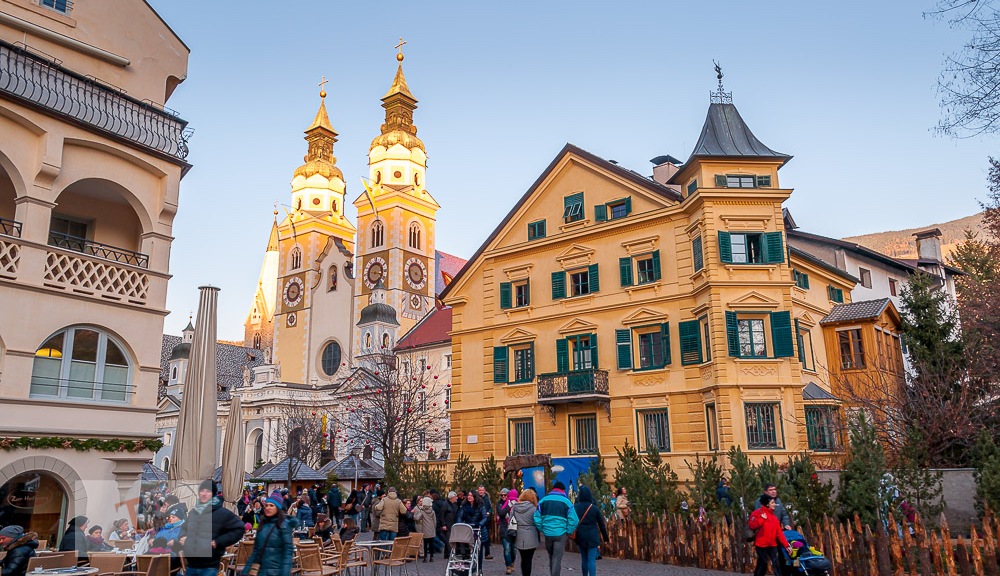
Beautiful city! Me too was fascinated by the cleanliness of the streets! Pretty Budapest!